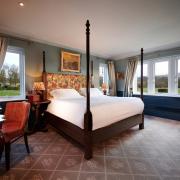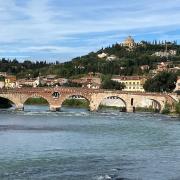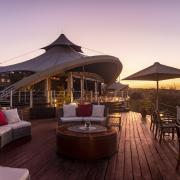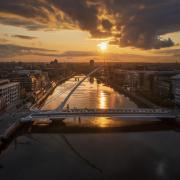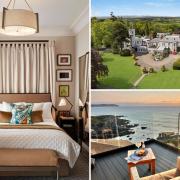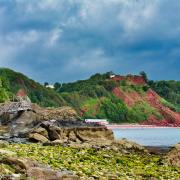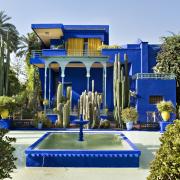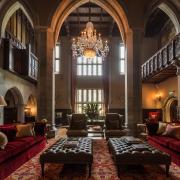The accent was pure French and the words so rapid fire that they all ran together. I shook my head confused as I tried to listen to the instructions. ‘Pardon?’ I ventured, asking the chef to repeat herself. ‘Make zee chicken bum cold with ice,’ she said, dead-pan and I began to laugh. Either my hearing was on the blink, or her accent was even stronger than I’d first thought.
We were in Chantilly, in Oise, 30 miles north of Paris, and Corrine was teaching us how to make the famous sweet cream. I’d expected vanilla and maybe even some liquor to be part of the titular recipe, but a chicken’s derriere was a surprising ingredient, to say the least.
Corrine saw my confusion and began laughing when I explained why. ‘Non,’ she spluttered. ‘No chicken please. It’s what we call the bowl – a cul de Poule – we whip it in, because of the shape.’


Chantilly Cream
Relieved, I focused on beating my cream until it was so firm I could hold said silver bowl over my head without a drip falling on me. ‘Tres bon,’ our teacher from the La Confrérie des Chevaliers Fouetteurs (the Brotherhood of Whipping Knights) announced, and we were allowed to taste the chicken-free delicacy.
It was delicious, of course, and the sweetest end to a wonderful day spent in Chantilly on a cruise from Pont L’Eveque to Paris on CroisiEurope’s barge, MS Raymonde. With just 11 ensuite cabins and six staff, this was my bijou floating home for the next few days, but while the barge was small it still had everything I could ever want on board. There was a cosy lounge with games, and a karaoke, a restaurant where the chef, Yves, created course after course of sublime French classics, a sun deck and a terrace with Jacuzzi.
Now sipping on a cocktail of the day, the first of which was served at 11am each morning – sooo French – I couldn’t believe we’d done so much already. We’d already toured The Château de Chantilly, the breathtakingly castle that was the home of Henri d’Orleans, Duke of Aumale, and son of the last French king, Louis-Phillipe. He had lovingly restored the chateau in 1871, two-thirds of which was destroyed during the French Revolution in 1798.

Castles
Strolling through boudoirs in delicate peacock blue, a parlour with chairs a deux designed for visitors to gossip in and the satiric Grand Singerie salon with painting on the walls of monkeys dressed up and imitating human behaviour, it was easy to see why this has been named one of the most beautiful castles in France.
Bequeathed to the Institut de France upon his death in 1886 on the express condition that nothing can be moved, sold or changed, Chantilly is like walking through history, where masterpieces including Botticelli’s Autumn have hung undisturbed as part of the second-largest collection of old paintings in France after the Louvre since the 19th century.

The library houses priceless manuscripts, and more than 50,000 books which are ordered by shape rather than alphabetical order.
A copy of the famous rose diamond is also on display – ‘the real one is hidden away,’ said our guide - , which Louis XIV gave to his cousin Louis de Bourbon, Prince of Conde, after his victory in the Battle of Rocroi in 1643.
Priceless, and with an irregularity on one side of the pink gem which made it instantly recognisable, thieves who stole it couldn’t sell it and hid the gem in an apple at the hotel they were staying in. A hungry maid tidying their room bit into it, and hitting something hard with her teeth, she thought the apple was bad and threw it on the fire. The next day she discovered the diamond in the embers. It was returned to Chantilly, but hasn’t been on display since 1926, as no one wants to lose it again.

Food Glorious Food
Back on board MS Raymonde, and with all traces of Chantilly cream gone, it was time for more cocktails before dinner. Our chef created hearty classics every night, including tasty vegetarian options, but before the three-meal course – with paired wines, of course – were served by the hilarious waitress Monica, we had a cheese show and tell.
Suzie, our purser, would reveal the star cheese of the evening – with suitable gasps of delight from us diners – before describing its history, taste and exactly how it would be served. As half of those onboard were French-speaking Canadians and the remainder English and Americans, she had to say it all in both languages. It was like being in a Eurovision Cheese Contest, and while the Langres, Brillat-Savarin, Saint-Maure de Toutaine, Comte and Epoisses scored highly, the clear winner, we all agreed, was the Morbier.
Every night Yves excelled himself, dishing up exquisite hand-made and local fayre, including mini quiche Lorraines, roasted guinea fowl stuffed with dried fruits, pork tenderloin in a forest crust, lamb leg marinated in spices, and Saithe fillet with scallops, with veggie versions for me, followed by desserts such as Meringue crumble, Grand Marnier mouse and strawberry salad, before the star cheese board was served to round it all off.
Breakfast and lunch were also included, along with all drinks, so I realised it was a good idea to make use of the complimentary bikes when we docked in pretty French villages, or head out on exclusive tours after dinner to walk off some of the calories.

Friends On Board
A barge holiday is an amazing way to make new friends, or spend quality time with family while being pampered. Cruising down the Oise river, going through locks, you get to see an entirely, and authentic, French way of life. It’s a gentle pace that is reinvigorating and left us all re-energised for when we glided into new places to explore.
CroisiEurope has managed to secure some amazing excursions for its guests, one of which was a visit to Notre Dame Cathedral in Noyon after dark. Having the doors opened to this first example of Gothic architecture in northern France in the 12th century was like revealing a secret just for us.
Others are of international importance, such as The Armistice Memorial in Compiègne, called The Glade of the Armistice in the forest in Picardy. The museum includes a replica of the emblematic train car used in the signing of the 11 November 1918 Armistice that ended World War I, later vindictively recommissioned by Adolf Hitler for the 1940 surrender of France during World War II.
The Armistice site was demolished three days later on Hitler’s orders and the train carriage taken to Berlin as a trophy of war. The memorial is dedicated to all soldiers who have fought since 1870, including Augustin Trébuchon—the last French soldier killed on the front during World War I. It was a sombre, yet fascinating visit, with photographs, film and artefacts from these troubled times.
It was a total contrast to see another palace, the neoclassical Château de Compiègne, which was built for Louis XV, restored by Napoleon, and was one of three ‘seats’ of royal governments alongside Versailles and Fontainebleau. Used as a hunting lodge because of its proximity to the Compiegne Forest, up to 600 would stay at the royal residence. We peered inside Napoleon’s scarlet bedroom – the colour of power – with its teeny bed and Goddess of War decor.

Final Resting Place
But perhaps the best excursion was saved until last when we went to Auvers-sur-Oise, the last home of artist Vincent Van Gogh. If the chateaux had been like travelling back in time, walking through the pretty village’s streets was like being in one of the artist’s paintings.
Van Gogh was only here for 70 days - arriving on 20 May, 1890 and dying on 29 July two days after shooting himself in the chest - but he was inspired to do 33 drawings and 74 paintings including iconic works such as The Church at Auvers and Wheatfield with Crows. Van Gogh chose the village as it was the home of Dr Gachet, a friend and doctor who specialised in treating melancholia.
He moved into The Ragout Inn in the village centre, a far cry from the hospital in Arles he'd been admitted to after cutting off his ear, and asylum in Saint-Remy, and painted landscapes of the surrounding countryside. Standing by Van Gogh’s grave, buried alongside his brother Theo, and covered with the ivy from Dr Gachet’s garden, was a sombre moment.
But there was no time to be sad for more than a moment as our next stop was the Musee de l’Absinthe, dedicated to the ‘Green Fairy’ - the preferred drink of poets and artists that came to symbolise decadence in 19th-century France. Originally conceived as a medicinal herbal preparation, this bitter apertif created blackouts and hallucinations as well as inspired the likes of Oscar Wilde and French poets Arthur Rimbaud and Charles Baudelaire.
At the end of the tour, after seeing all the paraphernalia used and warnings issued about the drink, we watched the Absinthe Ritual where a fountain dripped cold water onto a sugar cube balanced on top of a slotted spoon to take away the bitter taste of the shot. I shuddered, tasting it, bewildered how the verdant liquor was so popular during the Belle Epoque. But maybe served with some delicious Morbier, it would be delicious. So I bought a bottle to take home – even it didn’t go well with the cheese it would be a great souvenir of an amazing barge holiday and tour in an historic and beautiful part of France.
The Details
A six-night Oise Valley hotel barge cruise costs from £2,995 per person based on 2024 departures between April and October. The price includes return flights from London Gatwick, overseas transfers and the cruise with all meals and drinks, entertainment, excursions, use of onboard bicycles, Wi-Fi and port fees. www.croisieurope.co.uk




